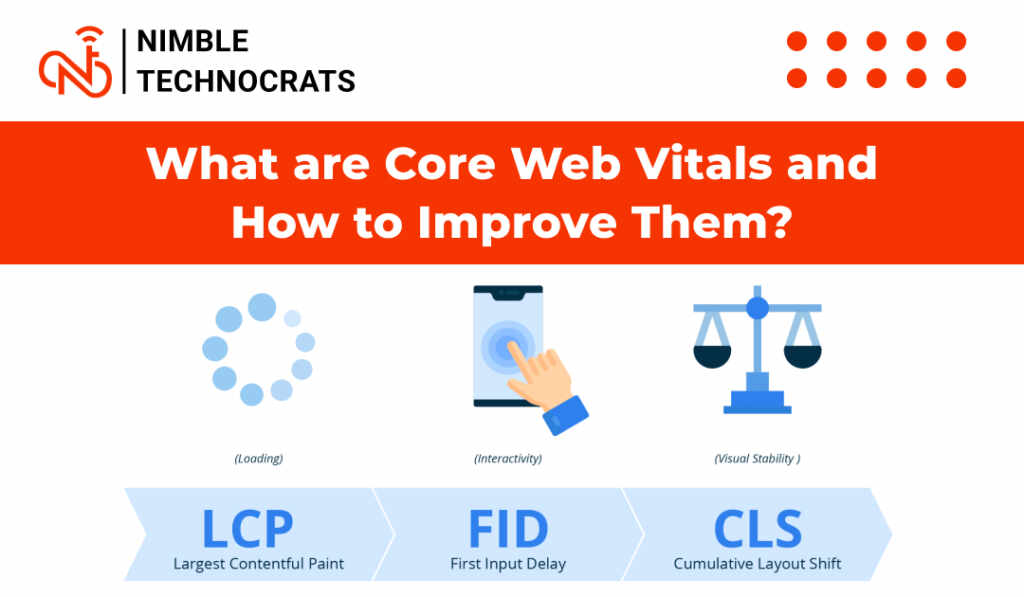The website’s success depends on how well-satisfied your clients are with it. To determine the quality of your user experience, Google considers several signals from a web page. There are three most important core web vitals. In this blog, we’ll talk about each core web vital.
What are Core Web Vitals?
To determine a user’s experience on a web page, Google uses core web vitals, which are a set of metrics. They measure how fast a page loads, how quickly users interact with the web page, and how stable the web page is when it loads. They are important for SEO because they help in determining the user experience of a website. A website with quick loading speed, and an interactive and stable layout is likely to offer a positive user experience.
Which are Currently the Most Important Core Web Vitals Metrics?
Largest Contentful Paint (LCP)
Basically, it measures the loading time of a web page. To measure it, the visible screen or user viewport is considered. To put it simply, LCP stands for Largest Contentful Paint. It represents the period between when a user clicks on a web link to open a webpage and when the largest image or text block on that page is fully loaded and visible. If your webpage has any heavy elements, such as high-resolution images, large scripts or multiple CSS imports, it will take longer to load and negatively impact your LCP score. Therefore, it’s crucial to ensure that your webpage is optimized for faster loading speed, which can improve your LCP score. Many of you may have seen the LCP issue on Google search console, so you should pay attention to it. The following optimizations are suggested to improve your LCP score:
- Image optimization: To accelerate their loading time, and reduce the file size of images.
- Use CDN: A content delivery network helps in distributing the content across several servers, minimizing the loading time.
- Server response time optimization: Ensure your server responds to requests quickly.
First Input Delay (FID)
First Input Delay (FID) is a web vital that measures how long it takes a web page to process a user input event. When a user interacts with an input field, such as clicking on a link, a form, or anchor text, Google starts tracking the time it takes from user input to the moment the site processes the event. The following optimizations can enhance your FID score:
- Reduce JavaScript execution time: JavaScript can result in delays in page responsiveness so be sure to optimize your scripts.
- Event handlers optimization: Be sure event handlers don’t cause delays and are efficient.
- Use a faster server: a faster server can minimize the time it takes for an input of a user to be processed.
Cumulative Layout Shift (CLS)
Cumulative Layout Shift is the metric used to measure the visual stability of a page from the user’s point of view. CLS refers to the stability of a web page. It checks how much the layout of a page moves around as the page loads and throughout the time period of a page. There are various core web vitals checker tools available that you can use to check your website’s core web vitals. The following CLS optimization should include:
- Specify video and image dimensions: It will not let the layout of the page shift which is caused by the loading of media files.
- Reserve space for embeds and ads: Pre-assign space for embeds and ads to prevent layout shifts when they load.
- Don’t add content above existing content: It can result in layout shifts, so be sure to add content below existing content.
FCP vs LCP
FCP: It stands for First Contentful Paint, which is a performance metric that measures the time it takes for the first element of the page to be processed and displayed in the user’s browser. FCP is ideal at 1.8 seconds.
LCP: It stands for Largest Contentful Paint which measures the time it takes for the largest content element on the page to process and load. The largest Contentful Paint should be less than 2.5 seconds to give a good user experience.
Conclusion
Now that you know about Core Web Vitals, how they can be improved and the difference between FCP and LCP. You should pay attention to the methods to improve core web vitals mentioned in this blog. Moreover, continue getting such information from Nimble Technocrats.
Other Useful Links:
Web Development Company in Melbourne
